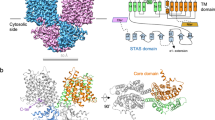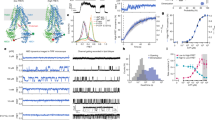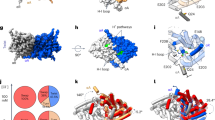Abstract
Chloride absorption and bicarbonate secretion are vital functions of epithelia1,2,3,4,5,6, as highlighted by cystic fibrosis and diseases associated with mutations in members of the SLC26 chloride-bicarbonate exchangers. Many SLC26 transporters (SLC26T) are expressed in the luminal membrane together with CFTR7, which activates electrogenic chloride-bicarbonate exchange by SLC26T8. However, the ability of SLC26T to regulate CFTR and the molecular mechanism of their interaction are not known. We report here a reciprocal regulatory interaction between the SLC26T DRA, SLC26A6 and CFTR. DRA markedly activates CFTR by increasing its overall open probablity (NPo) sixfold. Activation of CFTR by DRA was facilitated by their PDZ ligands and binding of the SLC26T STAS domain to the CFTR R domain. Binding of the STAS and R domains is regulated by PKA-mediated phosphorylation of the R domain. Notably, CFTR and SLC26T co-localize in the luminal membrane and recombinant STAS domain activates CFTR in native duct cells. These findings provide a new understanding of epithelial chloride and bicarbonate transport and may have important implications for both cystic fibrosis and diseases associated with SLC26T.
This is a preview of subscription content, access via your institution
Access options
Subscribe to this journal
Receive 12 print issues and online access
$209.00 per year
only $17.42 per issue
Buy this article
- Purchase on Springer Link
- Instant access to full article PDF
Prices may be subject to local taxes which are calculated during checkout





Similar content being viewed by others
References
Sokol, R.Z. Infertility in men with cystic fibrosis. Curr. Opin. Pulm. Med. 7, 421–426 (2001).
Wilschanski, M. & Durie, P.R. Pathology of pancreatic and intestinal disorders in cystic fibrosis. J. R. Soc. Med. 91, Suppl 34, 40–49 (1998).
Argent, B.E. & Case, R.M. in Physiology of the Gastrointestinal Tract 3rd ed. (ed. Johnson, L. R.) 1473–1497 (Raven Press, New York 1994).
Cook, D.I., Van Lennep, E.W., Roberts, M.L. & Young, J.A. in Textbook of Physiology of the Gastrointestinal Tract 3rd ed. (ed. Johnson, L. R.) 1061–1117 (Raven Press, New York, 1994).
Kunzelmann, K, & Mall, M. Electrolyte transport in the mammalian colon: mechanisms and implications for disease. Physiol Rev. 82, 245–289 (2002).
Hadorn, B., Johansen P.G. & Anderson C.M. Pancreozymin secretin test of exocrine pancreatic function in cystic fibrosis and the significance of the result for the pathogenesis of the disease. Can. Med. J. 98, 377–384 (1968).
Mount, D.B. & Romero, M.F. The SLC26 gene family of multifunctional anion exchangers. Pflugers Arch. 447, 710–721 (2004).
Ko, S.B., et al. A molecular mechanism for aberrant CFTR-dependent HCO3− transport in cystic fibrosis. EMBO J. 21, 5662–5672 (2002).
Sheppard, D.N. & Welsh, M.J. Structure and function of the CFTR chloride channel. Physiol Rev. 79, S23–S45 (1999).
Poulsen, J.H., Fischer, H., Illek, B. & Machen, T.E. Bicarbonate conductance and pH regulatory capability of cystic fibrosis transmembrane conductance regulator. Proc. Natl Acad. Sci. USA 91, 5340–5344 (1994).
Sohma, Y., Gray, M.A., Imai, Y. & Argent, B.E. HCO3− transport in a mathematical model of the pancreatic ductal epithelium. J. Membr. Biol. 176, 77–100 (2000).
Makela, S., Kere, J., Holmberg, C. & Hoglund, P. SLC26A3 mutations in congenital chloride diarrhea. Hum. Mutat. 20, 425–438 (2002).
Superti-Furga, A. et al. Achondrogenesis type IB is caused by mutations in the diastrophic dysplasia sulphate transporter gene. Nature Genet. 12, 100–102 (1996).
Everett, L.A., et al. Pendred syndrome is caused by mutations in a putative sulphate transporter gene (PDS). Nature Genet. 17, 411–422 (1997).
Lohi, H., et al. Functional characterization of three novel tissue-specific anion exchangers SLC26A7, -A8, and -A9. J. Biol. Chem. 277, 14246–14254 (2002).
Haila, S., et al. The congenital chloride diarrhea gene is expressed in seminal vesicle, sweat gland, inflammatory colon epithelium, and in some dysplastic colon cells. Histochem. Cell. Biol. 113, 279–286 (2000).
Melvin, J.E., Park, K., Richardson, L., Schultheis, P.J. & Shull, G.E. Mouse down-regulated in adenoma (DRA) is an intestinal Cl−/HCO3− exchanger and is up-regulated in colon of mice lacking the NHE3 Na+/H+ exchanger. J. Biol. Chem. 274, 22855–22861 (1999).
Soleimani, M. et al. Pendrin: an apical Cl−/OH−/HCO3− exchanger in the kidney cortex. Am. J. Physiol. 280, F356–364 (2001).
Wang, Z., Petrovic, S., Mann, E. & Soleimani, M. Identification of an apical Cl−/HCO3− exchanger in the small intestine. Am. J. Physiol. 282, G573–G579 (2002).
Xie, Q., Welch, R., Mercado, A., Romero, M.F. & Mount, D.B. Molecular characterization of the murine Slc26a6 anion exchanger: functional comparison with Slc26a1. Am. J. Physiol. 283, F826–F838 (2002).
Wang, S., Yue, H., Derin, R.B., Guggino, W.B. & Li, M. Accessory protein facilitated CFTR–CFTR interaction, a molecular mechanism to potentiate the chloride channel activity. Cell. 103, 169–179 (2000).
Lamprecht, G., et al. The down regulated in adenoma (dra) gene product binds to the second PDZ domain of the NHE3 kinase A regulatory protein (E3KARP), potentially linking intestinal Cl−/HCO3− exchange to Na+/H+ exchange. Biochemistry 41, 12336–12342 (2002).
Lohi, H. et al. Isoforms of the anion exchanger SLC26A6 mediate chloride and sulfate transport and have functional PDZ interaction domains. Am. J. Physiol. 284, C769–C779 (2002).
Aravind, L. & Koonin, E.V. The STAS domain — a link between anion transporters and antisigma-factor antagonists. Curr. Biol. 10, R53–R55 (2000).
Chernova, M.N. et al. Acute regulation of the SLC26A3 congenital chloride diarrhoea anion exchanger (DRA) expressed in Xenopus oocytes. J. Physiol. 549, 3–19 (2003).
Ostedgaard, L.S., Baldursson, O. & Welsh, M.J. Regulation of the cystic fibrosis transmembrane conductance regulator Cl− channel by its R domain. J. Biol. Chem. 276, 7689–7692 (2001).
Ishiguro H, et al. Membrane potential and bicarbonate secretion in isolated interlobular ducts from guinea-pig pancreas. J. Gen. Physiol. 120, 617–628 (2002).
Lee, M.G. et al. Cystic fibrosis transmembrane conductance regulator regulates luminal Cl−/HCO3− exchange in mouse submandibular and pancreatic ducts. J. Biol. Chem. 274, 14670–14677 (1999).
Ishiguro, H. et al. Chloride transport in microperfused interlobular ducts isolated from guinea-pig pancreas. J. Physiol. 539, 175–189 (2002).
Zeng, W. et al. Immuno and functional characterization of CFTR in submandibular and pancreatic acinar and duct cells. Am. J. Physiol. 273, C442–C455 (1997).
Choi, J.Y. et al. Aberrant CFTR-dependent HCO3− transport in mutations associated with cystic fibrosis. Nature 410, 94–97 (2001).
Colquhoun, D. & Hawkes, A.G. in Single-channel Recording (eds Sakmann, B. & Neher, E.), 135–174 (Plenum Press, New York, 1983).
Hanrahan, J.W. et al. Patch-clamp studies of cystic fibrosis transmembrane conductance regulator chloride channel. Methods Enzymol. 293, 169–194 (1998).
Acknowledgements
This work was supported by grants DE12309, DK38938, cystic fibrosis Foundation grant MUALLE01G0 (to S.M.), DK49835 (to P.T.), traning grant GM-08203 (M.R.D.), Pancreas Research Foundation of Japan (to S.K.) and the Ministry of Education, Science, Technology, Sports and Culture, Japan, and the Uehara Memorial Foundation (to S.N.). S.B.H.K. was supported by the Japan Health Sciences Foundation.
Author information
Authors and Affiliations
Corresponding author
Ethics declarations
Competing interests
The authors declare no competing financial interests.
Supplementary information
Supplementary Information, Figures
Fig. S1 (PPT 617 kb)
Fig. S2
Rights and permissions
About this article
Cite this article
Ko, S., Zeng, W., Dorwart, M. et al. Gating of CFTR by the STAS domain of SLC26 transporters. Nat Cell Biol 6, 343–350 (2004). https://doi.org/10.1038/ncb1115
Received:
Accepted:
Published:
Issue Date:
DOI: https://doi.org/10.1038/ncb1115
This article is cited by
-
Oxalate secretion is stimulated by a cAMP-dependent pathway in the mouse cecum
Pflügers Archiv - European Journal of Physiology (2023)
-
Pendrin: linking acid base to blood pressure
Pflügers Archiv - European Journal of Physiology (2023)
-
Human pancreatic ductal organoids with controlled polarity provide a novel ex vivo tool to study epithelial cell physiology
Cellular and Molecular Life Sciences (2023)
-
The digestive tract as an essential organ for water acquisition in marine teleosts: lessons from euryhaline eels
Zoological Letters (2021)



